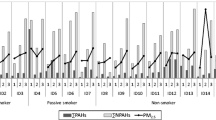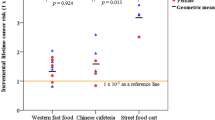Abstract
Objective
To examine the inhalation exposure of cooks at night markets in Taiwan to PAHs and to estimate the corresponding potential human health risks posed by the inhalation of carcinogenic PAHs.
Methods
Eight-hour personal air samples collecting particle-bound PAHs and XAD-2 retaining PAHs in the gas phase were taken by personal PM2.5 cyclones with cooks carrying the sampler on the shoulder while cooking at selected food stalls at four night markets in Taipei, and the concentrations of 16 priority PAHs in both particulates and air were measured with GC/MS.
Results
The total identified PAHs in both gas and PM2.5 phases exposed by cooks during cook hours ranged from 233,995 to 44,166 ng m−3. Total exposed PAHs in cooks, as well as the percentage of PAHs in PM2.5, were the highest at the barbecue stall F3. The fractions of gaseous PAHs (97%) in the four food stalls were consistently higher than the fractions of particulate PAHs (3%). The diagnostic ratios of PAHs fell within the range of those found in other studies related to cooking. At all typical food stalls in night markets except for F2, the excess lifetime cancer risk (ELCR) of cooks are beyond the acceptable target risk range of 10−6 to 10−4 for occupational workers set by USEPA.
Conclusion
The PAHs measured in the night markets originated from combustion due to food cooking. The control of gaseous PAH emissions would be more important than the fractions of particulate PAH emissions. Occupational exposure to cooking emissions in Taiwanese workers at night markets is of health concern. Thus, effective protective measures are therefore suggested to minimize cooks’ exposure to such emissions, such as wearing mask of activated carbon, evacuating the exhaust into water tank with bio-surfactant to improve PAH removal, installing effective mechanical exhaust vacuum or building high exhaust fume hood above cooking ovens.
Similar content being viewed by others
References
Cotham WE, Bidleman TF (1995) Polycyclic aromatic hydrocarbons and polychlorinated biphenyls in air at an urban and a rural site near Lake Michigan. Environ Sci Technol 29:2782–2789
Hart KM, Pankow JF (1994) High-volume air sampler for particle and gas sampling. 2. Use of backup filters to correct for the adsorption of gas-phase polycyclic aromatic hydrocarbons to the front filter. Environ Sci Technol 28:655–661
He LY, Hu M, Huang XF, Yu BD, Zhang YH, Liu DQ (2004) Measurement of emissions of fine particulate organic matter from Chinese cooking. Atmos Environ 38:6557–6564
Ho KF, Lee SC, Chiu GMY (2002) Characterization of selected volatile organic compounds, polycyclic aromatic hydrocarbons, and carbonyl compounds at a roadside monitoring station. Atmos Environ 36:57–65
International Agency for Research on Cancer (IARC) (1987) Overall evaluations of carcinogenicity: an updating of IARC monographs volumes 1 to 42. IARC Monogr Eval Carcinog Risk Chem Hum (suppl 7), Lyon, France
Jarvis D, Chinn S, Luczynska C, Burney P (1996) Association of respiratory symptoms and lung function in young adults with use of domestic gas appliances. Lancet 347:426–431
Ko YC, Cheng LS, Lee CH, Huang JJ, Huang MS, Kao EL, Wang HZ, Lin HJ (2000) Chinese food cooking and lung cancer in women nonsmokers. Am J Epidemiol 151:140–147
Li CT, Lin YC, Lee WJ, Tsai PJ (2003) Emission of polycyclic aromatic hydrocarbons and their carcinogenic potencies from cooking sources to the urban atmosphere. Environ Health Perspect 111:483–487
Lohmann R, Northcott GL, Jones KC (2000) Assessing the contribution of diffuse domestic burning as a source of PCDD/Fs, PCBs and PAHs to the UK atmosphere. Environ Sci Technol 34:2892–2899
Menichini E (2009) On-filter degradation of particle-bound benzo[a]pyrene by ozone during air sampling: a review of the experimental evidence of an artifact. Chemosphere 77:1275–1284
Nisbet ICT, LaGoy PK (1992) Toxic equivalency factors (TEFs) for polycyclic aromatic hydrocarbons (PAHs), Reg. Toxicol Pharmacol 16:290–300
Park SS, Kim YJ, Kang CH (2002) Atmospheric polycyclic aromatic hydrocarbons in Seoul, Korea. Atmos Environ 36:2917–2924
Richter H, Howard JB (2000) Formation of polycyclic aromatic hydrocarbons and their growth to soot—a review of chemical reaction pathways. Prog Energy Combust Sci 26:565–608
Scientific Committee on Foods of EC (SCF) (2002) Opinion of the Scientific Committee on Food in the risk to human health of PAHs in food. SCF, Brussels
See SW, Karthikeyan S, Balasubramanian R (2006) Health risk assessment of occupational exposure to particulate-phase polycyclic aromatic hydrocarbons associated with Chinese, Malay and Indian cooking. J Environ Monit 8:369–376
Tuominen J, Salomss S, Pyysalo H, Skytta E, Tikkanen L, Nurmela T, Sorsa M, Pohjola V, Sauri M, Himberg K (1988) Polynuclear aromatic hydrocarbons and genotoxicity in particulate and vapor phases of ambient air: effect of traffic season and meteorological conditions. Environ Sci Technol 22:1228–1234
U. S. Environmental Protection Agency (USEPA) (1989) Glossary of Terms Related to Health, Exposure, and Risk Assessment (EPA/450/3-88/016). Air Risk Information Support Center
U. S. Environmental Protection Agency (USEPA) (1992) Guidelines for exposure assessment. Fed Regist 57(104):22888–22938
United States Department of Energy (USDOE) (1999) Guidance for conducting risk assessments and related risk activities for the DOE-ORO environmental management program, BJC/OR-271, USDOE, 1999. Available at http://risk.lsd.ornl.gov/homepage/rap_docs.html
United States Department of Labor (USEOL) (2007) Occupational safety and health association, coal tar pitch volatiles: hazards and solutions. Content reviewed in 2007. Available at http://www.osha.gov/SLTC/coaltarpitchvolatiles/solutions.html
Zhao P, Lin CC (2010) Air quality at night markets in Taiwan. J Air Waste Manage Assoc 60:369–377
Zhu LZ, Wang J (2003) Sources and patterns of polycyclic aromatic hydrocarbons pollution in kitchen air, China. Chemosphere 50:611–618
Acknowledgments
The authors would like to thank all staff and students for providing assistance in sample collection and instrumental analysis at night markets. We also gratefully acknowledge the participating cooks at night markets who fully supported this research.
Conflict of interest statement
The authors have no conflicts of interest.
Author information
Authors and Affiliations
Corresponding author
Rights and permissions
About this article
Cite this article
Zhao, P., Yu, KP. & Lin, CC. Risk assessment of inhalation exposure to polycyclic aromatic hydrocarbons in Taiwanese workers at night markets. Int Arch Occup Environ Health 84, 231–237 (2011). https://doi.org/10.1007/s00420-010-0551-1
Received:
Accepted:
Published:
Issue Date:
DOI: https://doi.org/10.1007/s00420-010-0551-1




